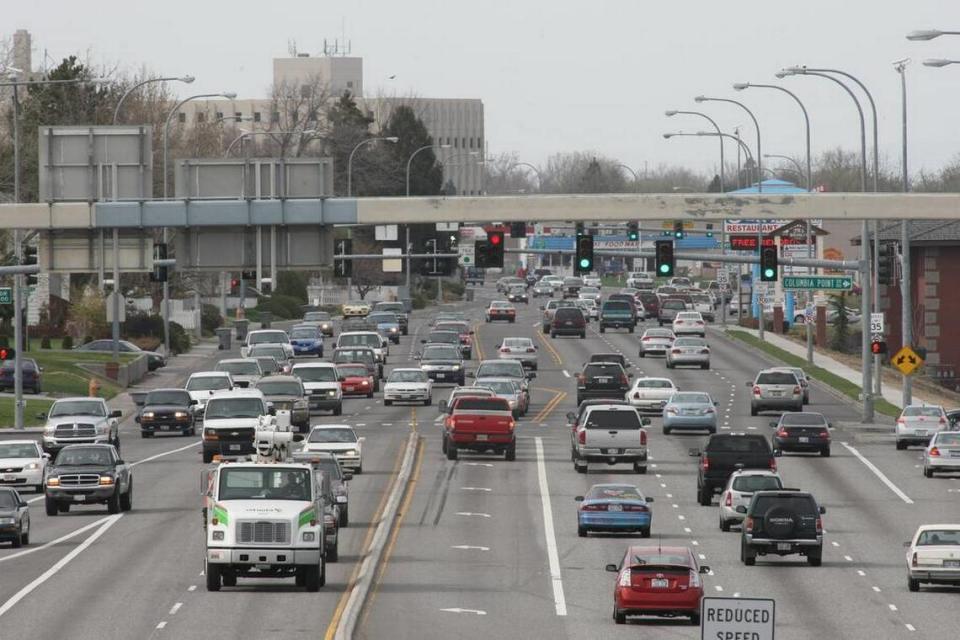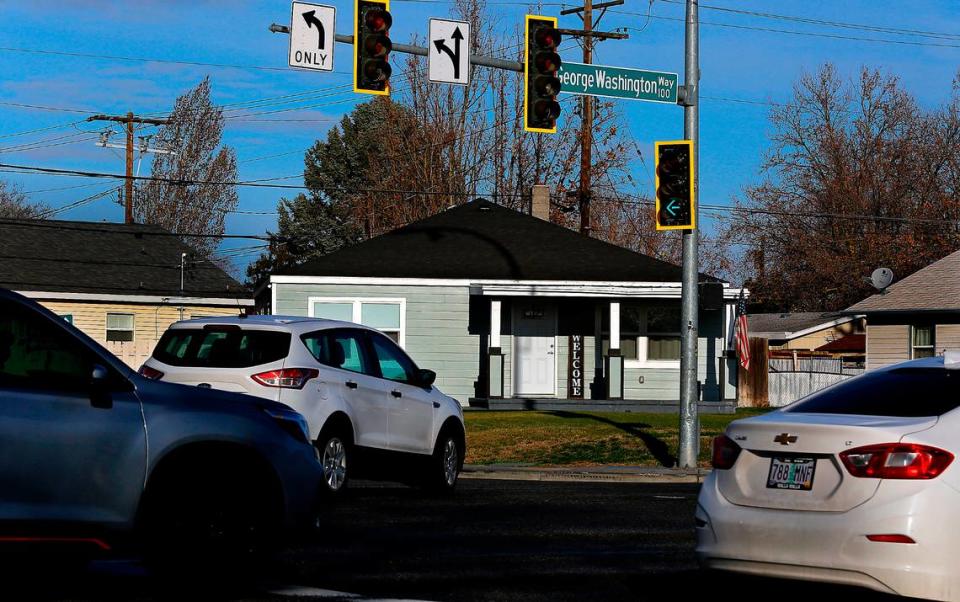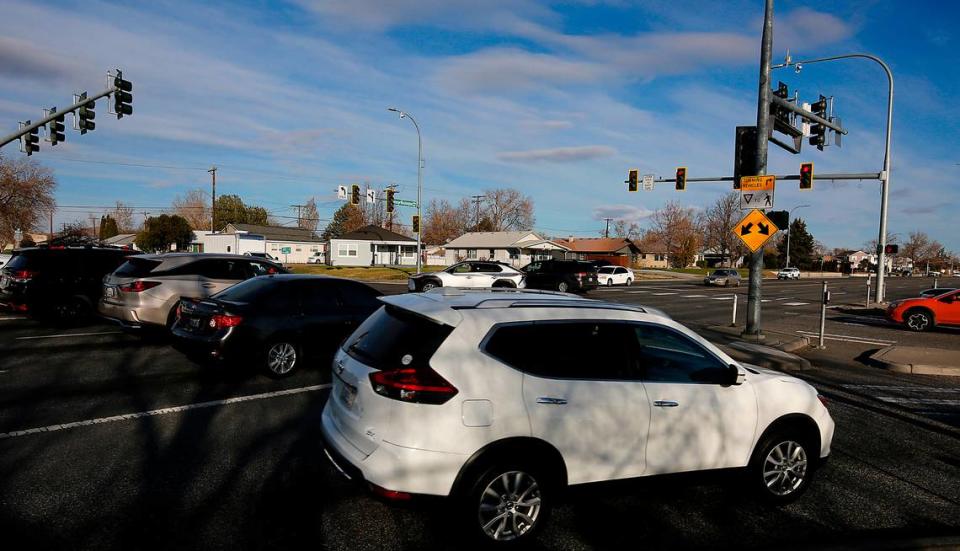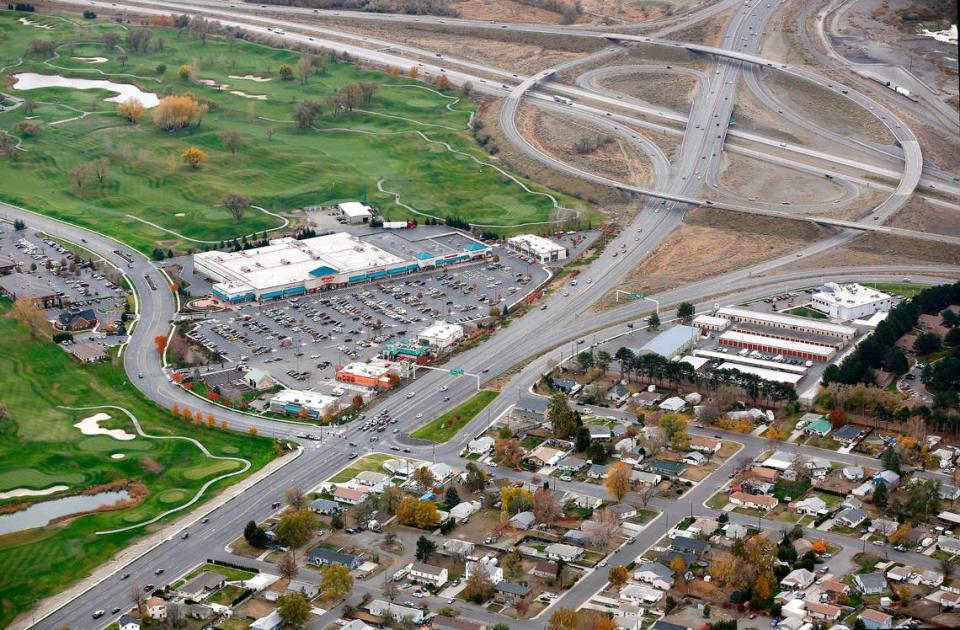Richland’s plan to tame troublesome GWay involves a bridge, a home and one-way streets
Richland is readying a pair of spendy road projects to untangle traffic on its busiest thoroughfare, George Washington Way.
The two projects, which total about $21 million, will add lanes and a pedestrian bridge at the Columbia Point Drive/Aaron Drive intersection and create a couplet through downtown by turning George Washington and Jadwin Avenue into one-way streets.
The city will finalize designs and funding this year and negotiate with adjacent properties that sit in the path of progress. Pete Rogalsky, the city’s public works director, updated the city council on the projects during its March 28 workshop.
Construction would begin in 2024, with the switch to the one-way streets continuing into the 2025 season.
Columbia Point
The intersection at Columbia Point Drive and Aaron Drive, near the WinCo-anchored shopping center, is the most congested and accident-prone in the city.
The proposal adds new lanes on George Washington Way and adds a third left turn lane outside of WinCo. It includes a dramatic pedestrian overpass soaring above traffic.
Some 41,000 vehicles use the intersection each day, according to a 2018 study cited by the Benton Franklin Council of Governments, which described the project in its 2023-2026 Call for Projects.
The council rates George Washington a “Tier 1” congested corridor and the worst in the Tri-Cities. It operates at a “D” level during the evening rush hour. By 2045, it is expected to reach the “F” level without some changes.
The intersection saw 94 wrecks, including 28 with injuries over five years. However, none of the crashes involved pedestrians or bicyclists.

George Washington provides critical access to employment centers, Kadlec Regional Medical Center, federal office buildings, higher ed facilities and the Pacific Northwest National Laboratory, among others, the study noted.
Fixing it is a priority in Richland’s comprehensive land use plan, its six-year transportation improvement plan and its capital improvement plan.
Previous upgrades such as a 2019 repaving project helped, but not enough.
“Growth and activity catches up with us and we fall behind again. We’ve never gotten ahead of the congestion,” Rogalsky said.
The city backed off from a 2015 overhaul that would have created a new intersection for Aaron Drive.
That vision would have required demolition of the beloved Tri-Cities Academy of Ballet and Music on Aaron. The plan was shelved following stern opposition to dislocating the ballet school.
Then traffic dipped because of COVID-19 pandemic shutdowns that sent workers home and kept many residents from driving around much.
“The only thing we got was a couple of years of pandemic that gave us a false sense of relief,” he told the council.
In 2021, it was ready to try again. It hired H.W. Lochner, a Spokane consultant, to reevaluate the intersection and suggest a new ideas. The $195,000 cost was paid with federal grants and real estate fees and includes engineering design work.
Rogalsky said Lochner reviewed the 2015 study, updated its traffic models and recommended a less disruptive solution. The new plan has less impact on most neighboring property owners, with one significant exception.
The pedestrian bridge requires demolishing a Hanford project-era “alphabet” house at Aaron and George Washington. The city expects to begin the process of buying it this year.

That was news to Israel Cantu, who owns the home with his wife.
Cantu said he learned of the plans from the Tri-City Herald. The Herald contacted the couple after the city council discussed eminent domain procedures in a publicly broadcast meeting.
Cantu and his wife paid $220,000 for their home in 2019 just before they married. It was the best deal in the Tri-Cities and they consider it a comfortable place to live, with sound proofing to protect them from traffic noise, he said.
Rogalsky said city staff was waiting to talk with the couple until after presenting the plan to the city council.
Intersection changes
The plan for the Columbia Point/Aaron Drive intersection: The city will add a full fourth southbound lane starting at about Benham Street and continuing through the intersection to the stretch where drivers split between Highway 240 to Kennewick or I-182 to either Pasco or Yakima.
Columbia Point Drive will gain a third left turn lane for drivers turning south onto George Washington. There are two left turn lanes at the WinCo entrance and traffic quickly backs up.
The additional lane will help “flush” vehicles through the intersection.
A pedestrian bridge is the most striking feature of the plan. As designed, it will cross the intersection at a diagonal, from the northwest corner on the Aaron Drive to the southeast corner on the Columbia Point Drive side.
Rogalsky said the bridge could serve as a monument at the city’s southern entrance. On a practical note, traffic signals will hang from the bridge, reducing the need for poles in the area.
Rogalsky said the diagonal layout is the best option to lure pedestrians and cyclists, who might otherwise use the crosswalk. A bridge is the safest option for pedestrians and bikers and it reduces the need to stop traffic on the street, where “WALK” signals are timed to accommodate the slowest walkers.
The bridge design complies with the Americans with Disabilities Act, with lengthy wheelchair friendly ramps on either side.

On the Aaron Drive side, the ramp will make a square around the spot where the Cantu family’s home currently sits. On the Columbia Point side, the ramp will slope along George Washington, with a single switchback to return users back to the intersection.
Rogalsky pledged the city will manage the process of acquiring the home under eminent domain laws designed to protect property owners against government powers. He said the process balances seller’s rights with the city’s obligation to be good stewards of public dollars, meaning it can’t simply offer an outrageous sum.
“It’s not my job to bring you a bad deal,” he said.
He said it would take a few months.
The intersection updates will cost $5 million to $6 million.
The Benton Franklin Council of Governments committed about $3.3 million and the city has committed $436,000.
The final $3.1 million will be included in the 2024 budget. Rogalsky said it is seeking funding from the traditional state and federal road funding programs.
Jadwin one-way
Richland has long viewed George Washington Way as a barrier between downtown and the Columbia River, its most important asset.

The concerns were codified in a splashy 2016 study by consultant Roger Brooks, who described it as Richland’s “Great Wall of China.”
The study inspired work to upgrade John Dam Plaza, the Parkway, Uptown Shopping Center and the Swift Boulevard corridor.
Now, it’s time to tackle George Washington Way by reducing the number of lanes that transit the city’s midsection.
Rogalsky said it can do that by making better use of George Washington and Jadwin Avenue, which offer motorists a combined nine travel lanes running north-south.
According to the Brooks report and Rogalsky, the city doesn’t need nine lanes.
Three in each direction will carry the load. George Washington can be reduced to three lanes by shifting southbound traffic to Jadwin, starting at Symons Street, and continuing until Jadwin merges with George Washington south of downtown.
The three-plus-three plan leaves three spare lanes. Rogalsky said the corridor can be reconfigured with bike lanes, wider sidewalks, stormwater facilities and even on-street parking.
“We heard from business owners in this area that they’d like to have some additional parking,” he said.
The project will require the city to buy a sliver of land at a gas station at Symons and George Washington Way to accommodate a turn lane.
The couplet will cost an estimated $16 million.
Funding sources include grants from the Benton Franklin Council of Governments, the state Transportation Improvement Board and the state Department of Ecology.
The city has committed $1.1 million and expects to dedicate $775,000 from its 2024 pavement preservation fund. The remaining $10.4 million will be funded through state and federal grants.
Construction would occur during the 2024 and 2025 construction seasons. The city will develop a schedule to minimize disruptions.
Rogalsky shot down a suggestion the city start charging tolls on George Washington Way to ensure non-Richland residents pay their share of the costs.
Only the Legislature can levy tolls, he said, adding that funding sources include federal and state grants.
It investigated the idea when it was arranging funding to build the Duportail Bridge over the Yakima River and learned city council’s can levy tolls.
Instead, Richland controversially created a Transportation Benefit District and levied a $20 car tab fee on vehicles registered in its jurisdiction.
The fee supports pavement maintenance and has been used to support George Washington Way.

